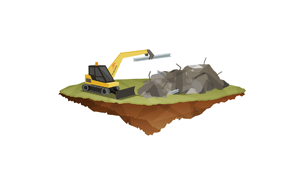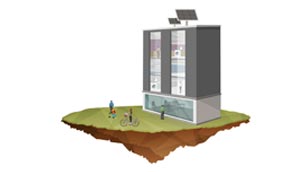Given both challenges – climate change and a growing world population, our long-term prosperity will depend not on things that we as individuals own, but on public buildings, energy, and transport infrastructure. And they need to be flexible to use, and built with strong, sustainable materials that are either reusable or endlessly recyclable.
Why is this important to us?
The future demands a vast investment in infrastructure in roads, bridges, railways, hospitals, schools, offices, renewable energy systems, river infrastructure and coastal defences.
The growth in deploying such new infrastructure is often driven or financed by the public sector, and experts are increasingly looking to new approaches in terms of design and construction to ensure that resources have the optimum impact over their lifetime. Maximizing steel’s suitability to strengthen the circular economy is critical to our approach in this sector.
Our challenge

As the demand for more sustainable construction materials rises, steel will have to prove its credentials against other alternatives, such as concrete and timber. This represents both a challenge and a significant opportunity for our sector. We have a track record in developing and commercialising more sustainable steels for infrastructure customers and we want to build on this in the years to come, and explore how we can make more reusable steel products. A large part of the challenge surrounds the legacy that today's infrastructure creates for the future, such as how useful and how valuable the materials we use now will be at the end of their current life.
Our action

We are investing in innovation, developing new products and engineering components for the construction and infrastructure sectors while working alongside our customers to meet their needs and anticipate future trends.
Areas we are exploring with customers include construction products that facilitate recycling, durable products for lease rather than sale, and business models that make it easier to recover and reuse of materials than to use and discard them.
We have the opportunity to work harder to prove and communicate the contribution steel can make to sustainability. Today, steel can already be produced with half the energy that was needed 40 years ago. But we need to further advance. We need to reduce even more the energy consumption and carbon emissions and to ensure that more steel is reused or recycled at the end of its useful life. This is a key element of circular economy thinking, which we explore in our Outcome 4.
Our potential to create value

The steel industry already meets much of the world's needs for sustainable construction and infrastructure. Our product is strong enough to build skyscrapers, versatile enough to meet any construction challenge, it has great potential for reuse, and is endlessly recyclable.
By using life cycle assessments and other techniques, our researchers can calculate where steel will bring added sustainability value compared with other materials – for example, as a result of its lower 'global warming potential' score, or the way it enables fast construction. Our innovations can ensure that modern infrastructure produces fewer carbon emissions and is more energy- efficient.
